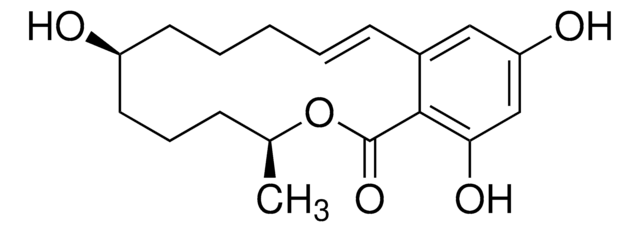CRM16869
Diquat metabolite Monopyridone
certified reference material, TraceCERT®, Manufactured by: Sigma-Aldrich Production GmbH, Switzerland
Synonyme(s) :
1-Oxo-9,10-dihydro-1H-10a-aza-8a-azoniaphenanthrene chloride, 6,7-Dihydro-9-oxo-9H-dipyrido[1,2-a:2′,1′-c]pyrazin-5-ium chloride
About This Item
Produits recommandés
Qualité
certified reference material
TraceCERT®
Niveau de qualité
Gamme de produits
TraceCERT®
Durée de conservation
limited shelf life, expiry date on the label
Fabricant/nom de marque
Manufactured by: Sigma-Aldrich Production GmbH, Switzerland
Format
neat
Température de stockage
2-8°C
Chaîne SMILES
O=C1N2CC[N+]3=CC=CC=C3C2=CC=C1.[Cl-]
InChI
1S/C12H11N2O.ClH/c15-12-6-3-5-11-10-4-1-2-7-13(10)8-9-14(11)12;/h1-7H,8-9H2;1H/q+1;/p-1
Vous recherchez des produits similaires ? Visite Guide de comparaison des produits
Catégories apparentées
Description générale
Certified content by quantitative NMR incl. uncertainty and expiry date are given on the certificate.
Download your certificate at: http://www.sigma-aldrich.com
Diquat monopyridone is a common degradation product of Diquat. Diquat is a nonselective, defoliant, preharvest, and desiccant herbicide that belongs to the bipyridinium class. Diquat can rapidly penetrate through the leaf surface but is not taken up by the roots, due to its strong adsorption onto the soil particles. Its activity is based on the liberation of the superoxide anion radical, followed by hydrogen peroxide, causing tissue destruction by oxidative stress. The herbicidal activity of diquat is more pronounced in daylight, aerobic conditions, high humidity, and temperature.
Diquat is not approved for its use in the European Union. The maximum residue limit (MRL) for diquat presence in the crops varies between 0.05 mg/kg in most of the commodities to 10 mg/kg for linseed and barley.
The EU residue definitions are broader, however, the toxicological data is still missing for the diquat metabolites, monopyridone and dipyridone, to compare their toxicity with the parent compound.
Application
- Detection of two diquat metabolites in urine and serum of poisoned patients after ingestion of combined herbicides, paraquat and diquat
- Analysis of paraquat, diquat, and two diquat metabolites in biological materials by high-performance liquid chromatography coupled with UV and fluorescence detectors
Informations légales
Vous ne trouvez pas le bon produit ?
Essayez notre Outil de sélection de produits.
Mention d'avertissement
Danger
Mentions de danger
Classification des risques
Acute Tox. 2 Inhalation - Acute Tox. 3 Dermal - Acute Tox. 3 Oral - Aquatic Acute 1 - Aquatic Chronic 1 - Eye Irrit. 2 - Skin Irrit. 2 - Skin Sens. 1 - STOT RE 1 Oral - STOT SE 3
Organes cibles
Respiratory system
Code de la classe de stockage
6.1A - Combustible acute toxic Cat. 1 and 2 / very toxic hazardous materials
Classe de danger pour l'eau (WGK)
WGK 2
Point d'éclair (°F)
Not applicable
Point d'éclair (°C)
Not applicable
Certificats d'analyse (COA)
Recherchez un Certificats d'analyse (COA) en saisissant le numéro de lot du produit. Les numéros de lot figurent sur l'étiquette du produit après les mots "Lot" ou "Batch".
Déjà en possession de ce produit ?
Retrouvez la documentation relative aux produits que vous avez récemment achetés dans la Bibliothèque de documents.
Notre équipe de scientifiques dispose d'une expérience dans tous les secteurs de la recherche, notamment en sciences de la vie, science des matériaux, synthèse chimique, chromatographie, analyse et dans de nombreux autres domaines..
Contacter notre Service technique
![[Des-Tyr22]-Calcitonin salmon](/deepweb/assets/sigmaaldrich/product/images/282/634/15345f68-95be-4b5f-abc2-cb170099f26f/640/15345f68-95be-4b5f-abc2-cb170099f26f.jpg)





